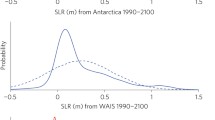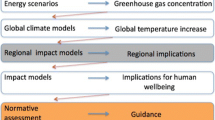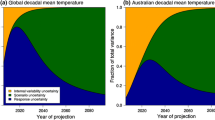Abstract
When do probability distribution functions (PDFs) about future climate misrepresent uncertainty? How can we recognise when such misrepresentation occurs and thus avoid it in reasoning about or communicating our uncertainty? And when we should not use a PDF, what should we do instead? In this paper, we address these three questions. We start by providing a classification of types of uncertainty and using this classification to illustrate when PDFs misrepresent our uncertainty in a way that may adversely affect decisions. We then discuss when it is reasonable and appropriate to use a PDF to reason about or communicate uncertainty about climate. We consider two perspectives on this issue. On one, which we argue is preferable, available theory and evidence in climate science basically exclude using PDFs to represent our uncertainty. On the other, PDFs can legitimately be provided when resting on appropriate expert judgement and recognition of associated risks. Once we have specified the border between appropriate and inappropriate uses of PDFs, we explore alternatives to their use. We briefly describe two formal alternatives, namely imprecise probabilities and possibilistic distribution functions, as well as informal possibilistic alternatives. We suggest that the possibilistic alternatives are preferable.
Similar content being viewed by others
Data Availability
NA.
Code availability
NA.
Notes
The “H + + ” scenarios of future, regional UK sea levels are examples of explorations of extremes [Lowe et al., 2009].
Partial PDFs already depart from probability theory. The point being made in this section is that imprecise probability theory provides further, useful departures.
Quantitative possibility measures can be interpreted as upper probabilities, which are tools of imprecise probability theory. This allows interpreting possibilistic representations using the tools of imprecise probability, though plausibly with a loss of information about uncertainty [Dubois and Prade, 1993 and 2015].
References
Bamber J, Aspinall W (2013) An expert judgement assessment of future sea level rise from the ice sheets. Nat Clim Chang 3:424–427. https://doi.org/10.1038/nclimate1778
Benjamin DJ (2019) Errors in probabilistic reasoning and judgment bias. In B. Douglas Bernheim, S. DellaVigna and D. Laibson (eds.) Handbook of Behavioral Economics - Foundations and Applications 2, pp. 69–186. Elsevier: London and Amsterdam
Baumberger C, Knutti R, Hadorn GH (2017) Building confidence in climate model projections: an analysis of inferences from fit. Wires Clim Change 8:e454. https://doi.org/10.1002/wcc.454
Betz G (2016) Accounting for possibilities in decision making. In: Hansson S., Hirsch Hadorn G. (eds) The Argumentative Turn in Policy Analysis. Logic, Argumentation & Reasoning (Interdisciplinary Perspectives from the Humanities and Social Sciences), vol. 10: 135–170. Springer, Cham
Borodina A, Fischer EM, Knutti R (2017) Potential to constrain projections of hot temperature extremes. J Clim 30(24):9949–9964. https://doi.org/10.1175/JCLI-D-16-0848.1
Bradley S (2019) Imprecise probabilities. In: Beisbart C, Saam NJ (eds) Computer Simulation Validation. Springer, pp 525–540
Clerc F, Minchew BM, Behn MD (2019) Marine ice cliff instability mitigated by slow removal of ice shelves. Geophys Res Lett 46(21):12108–12116. https://doi.org/10.1029/2019GL084183
DeConto RM, Pollard D (2016) Contribution of Antarctica to past and future sea-level rise. Nature 531:591–597. https://doi.org/10.1038/nature17145
Dubois D, Prade H, Sandri S (1993) On possibility/probability transformations. In: Lowen R, Roubens M (eds) Fuzzy Logic: State of the Art. Kluwer Academic, Dordrecht, pp 103–112
Dubois D, Prade H (2015) Possibility theory and its applications: where do we stand? In: Kacprzyk J, Pedrycz W (eds) Springer Handbook of Computational Intelligence. Springer Handbooks. Springer, Berlin, Heidelberg, pp 31–59
Fine TL (1988) Lower probability models for uncertainty and nondeterministic processes. J Stat Plann Inference 20(3):389–411. https://doi.org/10.1016/0378-3758(88)90099-7
Gleckler PJ, Taylor KE, Doutriaux C (2008) Performance metrics for climate models. J Geophys Res 113:D06104. https://doi.org/10.1029/2007JD008972
Hájek A “Interpretations of Probability”, The Stanford Encyclopedia of Philosophy (Fall 2019 Edition), E. N. Zalta (ed.), URL = <https://plato.stanford.edu/archives/fall2019/entries/probability-interpret/>
Hall J, Fu G, Lawry J (2007) Imprecise probabilities of climate change: aggregation of fuzzy scenarios and model uncertainties. Clim Change 81:265–281. https://doi.org/10.1007/s10584-006-9175-6
Halpern JY (2017) Reasoning about uncertainty, 2nd ed. The MIT Press, Cambridge, MA. https://doi.org/10.7551/mitpress/10951.001.0001
Hausfather Z, Drake HF, Abbott T, & Schmidt GA (2020) Evaluating the performance of past climate model projections, Geophysical Research Letters 47(1): e2019GL085378. https://doi.org/10.1029/2019GL085378
Heifetz A, Meier M, Schipper BC (2006) Interactive unawareness. J Econ Theory 130(1):78–94. https://doi.org/10.1016/j.jet.2005.02.007
Hinkel J, Church JA, Gregory JM, Lambert E, Le Cozannet G, Lowe J et al (2019) Meeting user needs for sea level rise information: a decision analysis perspective. Earth’s Future 7:320–337. https://doi.org/10.1029/2018EF001071
Hulme M, Jenkins GJ, Lu X, Turnpenny JR, Mitchell TD, Jones RG, Lowe J, Murphy JM, Hassell D, Boorman P, McDonald R, Hill S (2002) Climate change scenarios for the United Kingdom: the UKCIP02 Scientific Report. University of East Anglia, Norwich, Tyndall Centre for Climate Change Research and School of Environmental Sciences
IPCC (2013) Summary for policymakers. In: Climate Change 2013: The physical science basis. Contribution of working group I to the Fifth assessment report of the Intergovernmental Panel on Climate Change [Stocker, T.F., D. Qin, G.-K. Plattner, M. Tignor, S.K. Allen, J. Boschung, A. Nauels, Y. Xia, V. Bex and P.M. Midgley (eds.)]. Cambridge University Press, Cambridge and New York
Katzav J (2013) Severe testing of climate change hypotheses. Stud Hist Philos Mod Phys 44(4):433–441. https://doi.org/10.1016/j.shpsb.2013.09.003
Katzav J (2014) The epistemology of climate models and some of its implications for climate science and the philosophy of science. Stud Hist Phil Mod Phys 46(B):228–238. https://doi.org/10.1016/j.shpsb.2014.03.001
Katzav J, Parker WS (2015) The future of climate modeling. Clim Change 132:475–487. https://doi.org/10.1007/s10584-015-1435-x
Knutti R, Furrer R, Tebaldi C, Cermak J, Meehl GA (2010) Challenges in combining projections from multiple climate models. J Climate 23(10):2739–2758. https://doi.org/10.1175/2009JCLI3361.1
Le Cozannet G, Manceau JC, Rohmer J (2017) Bounding probabilistic sea-level projections within the framework of the possibility theory. Environ Res Letters 12:014012. https://doi.org/10.1088/1748-9326/aa902a
Lee Y-J, Marotzke J (eds) (2021) Chapter 4: Future global climate: scenario-based projections and near-term information. In IPCC 2021: AR6 Climate Change 2021: The Physical Science Basis. Cambridge University Press
Lovejoy S (2015) A voyage through scales, a missing quadrillion and why the climate is not what you expect. Clim Dyn 44:3187–3210. https://doi.org/10.1007/s00382-014-2324-0
Lowe JA, Howard T, Pardaens A, Tinker J, Holt J, Wakelin S, Milne G, Leake J, Wolf J, Horsburgh K, Reeder T, Jenkins G, Ridley J, Dye S, & Bradley S (2009) UK climate projections science report: marine and coastal projections. Met Office Hadley Centre. http://ukclimateprojections.defra.gov.uk
Lowe JA, Bernie D, Bett P, Bricheno L, Brown S, Calvert D, Clark R, Eagle K, Edwards T, Fosser G and Fung F (2018) UKCP18 science overview report. Exeter, UK: Met Office Hadley Centre
Mendlik T, Gobiet A (2016) Selecting climate simulations for impact studies based on multivariate patterns of climate change. Clim Change 135(3–4):381–393. https://doi.org/10.1007/s10584-015-1582-0
Milinski S, Maher N, Olonscheck D (2020) How large does a large ensemble need to be? Earth Syst Dyn 11:885–901. https://doi.org/10.5194/esd-11-885-2020
Millner A, Calel R, Stainforth D, MacKerron G (2013) Do probabilistic expert elicitations capture scientists’ uncertainty about climate change? Clim Change 116(2):427–436. https://doi.org/10.1007/s10584-012-0620-4
O’Hagan A (2019) Expert knowledge elicitation: subjective but scientific. Am Stat 73(sup1):69–81. https://doi.org/10.1080/00031305.2018.1518265
Parker WS (2010) Whose probabilities? Predicting climate change with ensembles of models. Philos Sci 77(5):985–997. https://doi.org/10.1086/656815
Parker WS, Winsberg E (2018) Values and evidence: how models make a difference. Eur J Philos Sci 8:125–142. https://doi.org/10.1007/s13194-017-0180-6
Pattyn F, Morlighem M (2020) The uncertain future of the Antarctic ice sheet. Science 367:1331–1335. https://doi.org/10.1126/science.aaz5487
Risbey J, Lamb P, Miller R, Morgan M, Roe G (2002) Exploring the structure of regional climate scenarios by combining synoptic and dynamic guidance and GCM output. J Clim 15(9):1036–1050. https://doi.org/10.1175/1520-0442(2002)015%3c1036:ETSORC%3e2.0.CO;2
Risbey J, O’Kane T (2011) Sources of knowledge and ignorance in climate research. Clim Change 108(4):755–773. https://doi.org/10.1007/s10584-011-0186-6
Risbey J, Squire D, Black A, DelSole T, Lepore C, Matear R, Monselesan D, Moore T, Richardson D, Schepen A, Tippett M, Tozer C (2021) Standard assessments of climate forecast skill can be misleading. Nat Commun 12(4346):1–14. https://doi.org/10.1038/s41467-021-23771-z
Schmidt GA, Sherwood S (2015) A practical philosophy of complex climate modelling. Eur J Philos Sci 5(2):149–169. https://doi.org/10.1007/s13194-014-0102-9
Schmidt GA, Bader D, Donner LJ, Elsaesser GS, Golaz J-C, Hannay C, Molod A, Neale RB, Saha S (2017) Practice and philosophy of climate model tuning across six US modeling centers. Geosci Model Dev 10:3207–3223. https://doi.org/10.5194/gmd-10-3207-2017
Shepherd T (2014) Atmospheric circulation as a source of uncertainty in climate change projections. Nat Geosci 7(10):703–708. https://doi.org/10.1038/ngeo2253
Shepherd T, Boyd E, Calel R, Chapman S, Dessai S, Dima-West I, Fowler H, James R, Maraun D, Martius O, Senior C, Sobel A, Stainforth D, Tett S, Trenberth K, van den Hurk B, Watkins N, Wilby R, Zenghelis D (2018) Storylines: an alternative approach to representing uncertainty in physical aspects of climate change. Clim Change 151:555–571. https://doi.org/10.1007/s10584-018-2317-9
Sherwood SC, Webb MJ, Annan JD, Armour KC, Forster PM, Hargreaves JC et al (2020) An assessment of Earth’s climate sensitivity using multiple lines of evidence. Reviews of Geophysics 58:e2019RG000678. https://doi.org/10.1029/2019RG000678
Stainforth DA, Allen MR, Tredger ER, Smith LA (2007) Confidence, uncertainty and decision-support relevance in climate predictions. Phil Trans R Soc A 365(1857):2145–2161. https://doi.org/10.1098/rsta.2007.2074
Taylor KE, Stouffer RJ, Meehl GA (2012) An overview of CMIP5 and the experiment design. Bull Am Meteor Soc 93(4):485–498. https://doi.org/10.1175/BAMS-D-11-00094.1
Tebaldi C, Knutti R (2007) The use of the multi-model ensemble in probabilistic climate projections. Philos Trans R Soc Math Phys Eng Sci 365(1857):2053–2075. https://doi.org/10.1098/rsta.2007.2076
Thompson E, Frigg R, Helgeson C (2016) Expert judgment for climate change adaptation. Philos Sci 83(5):1110–1121. https://doi.org/10.1086/687942
Thompson EL, Smith LA (2019) Escape from model-land. Economics 13(2019–40):1–15. https://doi.org/10.5018/economics-ejournal.ja.2019-40
Weisheimer A, Palmer TN (2014) On the reliability of seasonal climate forecasts. J R Soc Interface 11:20131162. https://doi.org/10.1098/rsif.2013.1162
Funding
David A. Stainforth.
The U.K. Economic and Social Research Council (ES/R009708/1) Centre for Climate Change.
Economics and Policy (CCCEP); The Grantham Research Institute on Climate Change and the Environment.
James Risbey.
The Decadal Climate Forecast Project at CSIRO.
Author information
Authors and Affiliations
Contributions
Joel Katzav, Erica L. Thompson, James Risbey, and David A. Stainforth were involved in conceptualisation, developing the methodology, investigation, writing, and reviewing and editing. Seamus Bradley was involved in conceptualisation, writing, and reviewing and editing. Mathias Frisch was involved in conceptualisation and reviewing and editing.
Corresponding author
Ethics declarations
Ethics approval
NA
Consent to participate
NA
Consent for publication
All the authors have consented to the publication of the manuscript.
Conflict of interest
The authors declare no competing interests.
Additional information
Publisher's Note
Springer Nature remains neutral with regard to jurisdictional claims in published maps and institutional affiliations.
This article belongs to the topical collection “Perspectives on the quality of climate information for adaptation decision support”, edited by Marina Baldissera Pacchetti, Suraje Dessai, David A. Stainforth, Erica Thompson, and James Risbey.
Rights and permissions
About this article
Cite this article
Katzav, J., Thompson, E.L., Risbey, J. et al. On the appropriate and inappropriate uses of probability distributions in climate projections and some alternatives. Climatic Change 169, 15 (2021). https://doi.org/10.1007/s10584-021-03267-x
Received:
Accepted:
Published:
DOI: https://doi.org/10.1007/s10584-021-03267-x




